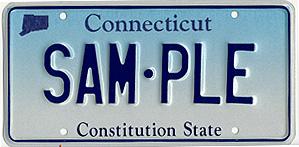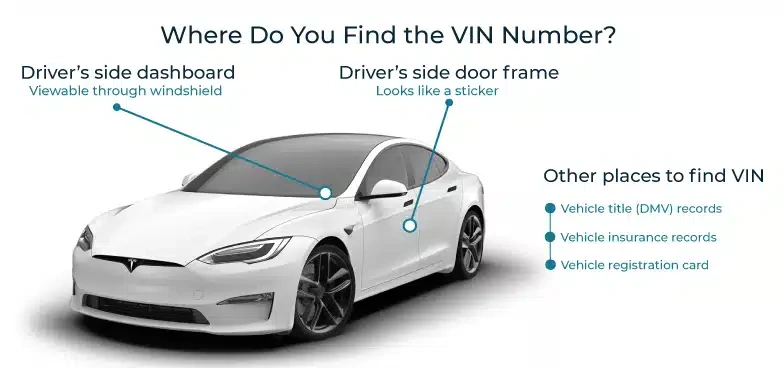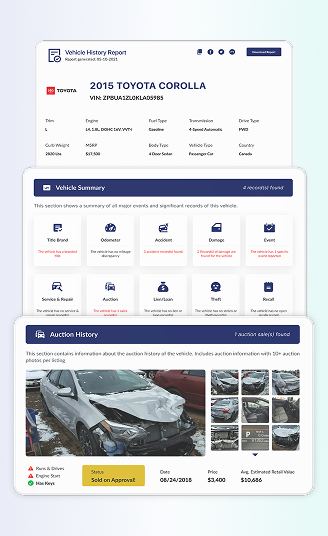Connecticut License Plate Lookup
With our Connecticut license plate lookup, you can check any vehicle license plate to uncover the vehicle’s history and hidden records.
Table of Contents
What is a Connecticut License Plate Lookup?
The Connecticut license plate lookup is a helpful tool for accessing a vehicle history report using only the plate number. It works as a background check for both buyers and sellers, reducing the risk of scams and ensuring the vehicle is in reliable condition before any deal is made.
Through the vehicle history report, you can review key details such as accident records, auction history, open recalls, warranty status, ownership history, mileage accuracy, and more. This information gives you a clear picture of the vehicle’s past and helps you make a good decision.
Is there a Free Connecticut License Plate Lookup?
You can use our free license plate lookup; however, please remember that the information provided in the free report differs from that in the paid report. Here are the details to expect on the free version of the CT license plate lookup.
- Associated VIN number
- Year, Make, and Model
- Country of Origin
- Market Value
- Transmission Type
- Fuel Type
- Drive Type
- Body Type
- Trim Information
- MSRP
- Engine Specifications
- Dimensions
- VIN
- Engine Value
- MSRP
- Manufacturer
- Fuel Type
- Body Type
- Year & Model
- Transmission
- Vehicle Type
- Sales Record
- Drive Type
- Mileage
- Market Value
- Doors
- Country of Origin
Why Conduct a License Plate Lookup in CT?
A recent case emerged in Connecticut, in which the dealer failed to undergo a safety inspection of their vehicle. This underscores the importance of checking the license plate before buying a used vehicle, whether for personal use or to sell.
A license plate lookup reveals detailed information about a car’s past, including its service history, number of previous owners, recalls, title issues, and more. You do not want to purchase a used car with an unknown history that could affect your safety.
For sellers, providing reliable information helps buyers shop safely and confidently at your store. Thus, having a vehicle history helps you determine the price fairly. If you’re honest, you avoid fights later on. Plus, a good history report makes your car look better to buyers.
Information You Can Find Through the Connecticut License Plate Lookup
With our Connecticut license plate lookup, you can get a vehicle history report that will show you all the information of the vehicle. Here’s the list of information on the report.
Vehicle Specification
Confirm the car’s year, make, model, trim, MSRP, drive type, country of origin, and engine type to ensure its authenticity and suitability for your needs.
Accident History
Access detailed records of past accidents, including the extent of damage and completed repairs, to evaluate the car’s condition. See the date and location where the accident happened.
Ownership History
Learn about the car’s previous owners, how long they owned it, the year of purchase, and the location of the vehicle.
Sales Records
Review past ownership changes and sales data to understand the vehicle transaction history. In this section, you will also see the date of sales and the vehicle’s sales price.
Auction History
Find out if the car was sold at auction, which could indicate quality issues or market interest. Check the date, location, and the final price of the vehicle.
Title Status
Verify whether the title is clean, salvaged, rebuilt, or branded to assess its legal and physical status. Make sure that the vehicle’s title is clean before you proceed to buy the vehicle.
Lien/Loan Records
Check for existing liens or unpaid loans that might complicate ownership transfer. In this section, you will see if the lien/loan records were cleared by the previous owner.
Open Recalls
Identify any unresolved safety recalls or defects that require attention. Examine the cause of recalls, the date, and the resolution to fix the recalls.
Theft Records
Confirm that the vehicle has not been reported stolen. Check the date, location, and the data source of the vehicle.
Odometer Reading
Validate the mileage to check for accuracy and estimate the car’s usage and wear. Verify the recorded mileage (along with the date) and the last known mileage of the vehicle.
Service and Maintenance History
Examine past repairs and servicing records to understand how well the vehicle was maintained. In this section, you can see the date, location, and the service or maintenance performed on the vehicle.
Warranty Coverage
Check if the vehicle was used as a personal vehicle, rental, lease, police unit, or government vehicle.
Why Securing the Vehicle Report is Crucial in CT?
Sabrina wanted to buy a 2014 CADILLAC ESCALADE from a private seller. Before she proceeds to buy, she decides to use the Connecticut license plate lookup.
Actual Condition
- 1 accident record
- 2 Record(s) of damage
- 1 specific event reported
- 1 auction record
- 1 lien or loan record
Seller’s Claim
- Never been in an accident
- Clean title
- Cleared lien/loan
- Had no damage
- A bit lower than the other dealership
Actual Condition
- To help you examine all the hidden information that wasn’t disclosed by the seller.
Outcome
- Gideon decided to call it off and look for another dealership
How Does the License Plate Lookup Work?
To perform a license plate lookup, follow these steps to get your report within seconds.
Enter the License Plate Number
Start by identifying the license plate number of the vehicle you’re interested in. If you don’t have it, request it directly from the seller or dealer.
Fill Out the Form
Type the license plate number into the form above and press the button to continue.
Access the Report
After a short wait, the system will create the report. Complete the payment, and you’ll be able to view and download the full vehicle history report.
Why You Should Run the Connecticut License Plate Lookup With Us?
- Vehicle Specifications – Year, make, model, trim, engine details, and other key specs.
- Auction & Sales Records – Includes up to 10 photos and transaction history.
- Mileage Verification – Confirms accurate odometer readings.
- Accident Records – Reports of past accidents and repair history.
License Plate Regulation in Connecticut
Connecticut’s Department of Motor Vehicles oversees vehicle registration and license plates. The state law mandates that vehicles must issue two license plates and display the plates on the front and rear sides of the vehicle; this law applies to most passenger cars.
Note that different types of vehicles, like motorbikes or trailers, may require different license plate placement.
License Plate Types and Design in Connecticut

The standard types of license plates were introduced in 2000. The design features a gradient blue background combined with dark blue lettering. The word “Connecticut” is centered at the top, while the slogan “Constitution State” is at the bottom to highlight the state’s deep history with the United States Constitution. In August 2015, the state transitioned to a seven-character serial format (AB 12345) to accommodate the increasing number of registered vehicles.
Types of License Plates Available in Connecticut
The government of Connecticut offers residents the option of requesting a different type of license plate in addition to the standard one. However, applying for this plate type might have an additional fee.
Standard Plates
This is the most common type of plate used by Connecticut residents. It features a gradient of blue and navy lettering, and the slogan highlights the strong history between the United States and Connecticut regarding the Constitution.
Vanity Plates
Vanity Plates allow the vehicle owner to fully customize their license plate with custom combinations of numbering and lettering with up to seven characters. They are subject to availability and state approval.
Special Plates
Connecticut offers various special license plates for different purposes. These plates allow vehicle owners to show support for causes, institutions, or affiliations while maintaining a unique vehicle identity.
Below are some of the available options:
Military Plates
These plates are designed for veterans and active-duty service members. They honor different military branches, such as the Army, Navy, Air Force, and Marines. Some military plates may also recognize service in specific wars or conflicts.
Charitable Organization Plates
These plates feature designs linked to nonprofit organizations, supporting causes like wildlife conservation, cancer awareness, and community services. Choosing one of these plates helps promote and fund important initiatives across Connecticut.
Collegiate Plates
Connecticut offers collegiate plates representing various state colleges and universities for those who want to show school spirit. These plates often feature school logos or colors, making them a great choice for alumni and students.
Specialty License Plates
Connecticut DMV also issues specialty plates for motorcycles, trailers, and nonstandard vehicles. These plates are usually smaller and have a simplified design, so they fit properly on different vehicle types.
License Plate Costs in Connecticut
In Connecticut, registering a standard passenger vehicle for three years comes with several fees combined into one total cost. On average, drivers can expect to pay between $150 and $200 for a new or transferred 3-year registration, though the exact amount depends on the type of vehicle and any extra charges that may apply.
Fee Breakdown for a 3-Year Passenger Vehicle Registration:
- Registration Fee: $120 for a standard passenger car.
- Plate Fee: $5 to issue standard plates.
- Administrative Fee: $10 processing charge.
- Clean Air Act Fee: $15.
- Passport to the Parks Fee: $15, which will increase to $24 starting July 1, 2025.
- Estimated Total: Around $165 before adding title or other applicable charges.
Other Fees You Might Encounter:
- Title Fee: $25 when registering a vehicle in your name for the first time.
- Emissions Exemption Fee: $40 for vehicles four years old or newer, which are exempt from emissions testing.
- Greenhouse Gas Fee: $10 applied to certain vehicles with a certificate of origin.
How to Register a License Plate in Connecticut?
To register a vehicle in Connecticut, you’ll need to complete both steps through the Connecticut Department of Motor Vehicles (DMV). When buying or receiving a vehicle, the seller must sign the title over to you. Once you have the title, you must:
- Provide proof of ownership (the signed title or other acceptable documents).
- Show proof of insurance that meets Connecticut’s minimum requirements.
- Complete the Application for Registration and Certificate of Title (Form H-13B).
- Pay the required title and registration fees.
- Submit a Bill of Sale if the vehicle was purchased privately.
After completing these steps, the DMV will issue the new title in your name and provide Connecticut license plates for your vehicle.
How to Transfer License Plates in Connecticut?
In Connecticut, license plates usually stay with the owner rather than the vehicle. If you sell your car and buy another, you can transfer your existing plates to the new vehicle. To do this, you must:
- Visit a Connecticut DMV office or use their online services.
- Provide your current plate number and vehicle information.
- Submit proof of insurance for the new vehicle.
- Pay the plate transfer fee, which is typically lower than getting new plates.
Replacing a Damaged, Stolen, or Lost License Plate in CT
If your license plates are damaged, lost, or stolen in Connecticut, you can easily replace them by following these steps:
- For Damaged Plates: You can request a replacement online by providing your driver’s license number, license plate information, and the applicable fee.
For Lost or Stolen Plates:
- Report to the Police: If your plates are stolen, file a police report first.
- Complete Form E-159: Fill out the Form E-159 for lost or stolen plates.
- Submit Documents: Bring the completed form, your vehicle registration, proof of insurance, and the police report (if applicable) to a Connecticut DMV office.
- Pay the Replacement Fee: A fee is required for replacement, but this can be reduced if you provide the police report.
By following these steps, you can quickly get new plates and ensure your vehicle is legally compliant again.
Connecticut License Plate Owner Lookup – What’s Allowed?
- Vehicle specifications (make, model, year, trim).
- Accident or damage history.
- Odometer records.
- Title and lien status.
- Recalls and theft records.
- However, personal details like the owner’s name, address, or contact information are not available to the general public.
Fun Facts About Connecticut
- The state legislature officially adopted the Connecticut slogan in 1973, though it had been used unofficially for years prior.
- Connecticut began issuing license plates in 1937 with the state name permanently embossed on them.
- The current standard plate design, featuring a blue-and-white gradient, is meant to represent the state’s nickname, the “Constitution State.”
Other Vehicle Check Tools
VIN Decoder
Window Sticker Lookup
Build Sheet by VIN
Classic Car History Report
License Plate Lookup By States
Our license plate check is not only available in Connecticut. Our license plate lookups are widely available in all the states listed below.
Connecticut License Plate Lookup FAQs
Q. Can I find someone’s name on a license plate?
A. Yes, but you must submit an official request to your local DMV. They may require a valid reason, such as legal or insurance purposes, and you might need to follow privacy laws before accessing the owner’s details.
Q. Why do people not put a front license plate?
A. In the United States, variations in motor vehicle regulations, often driven by design preference, result in some states requiring only a rear-mounted license plate, thus forgoing the traditional front plate.
Q. Is it illegal to show someone’s license plates online?
A. Publishing videos with visible license plates carries potential legal risks, including lawsuits. Moreover, criminals exploit plate numbers for serious offenses. Therefore, anonymizing videos by blurring license plates protects individual privacy and minimizes legal exposure.
Q. Can I get the license plate report from the VIN number?
A. Yes, definitely. The VIN number remains invaluable for assessing any vehicle’s history using our reliable VIN check tool. It can be 17 digits for cars manufactured after 1981 or 5 – 14 digits for classic cars or vehicles manufactured prior to 1981.


